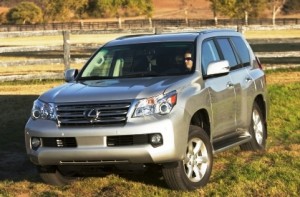Consumer Reports revoked its “Don’t Buy: Safety Risk” designation from the 2010 Lexus GX 460 SUV this morning, saying that recall work corrected the problem it displayed in one of its emergency handling tests. (See Japanese Stop Sales of 2010 Lexus GX460)
CR is not really endorsing the Lexus though, continuing a recent trend of distancing itself from Toyota products after years of automatically endorsing them. CR says that with the fix, the GX 460’s handling is ultimately okay, but is “still ponderous and ungainly, as is common with traditional body-on-frame SUVs.” (See also Consumers Union Defends Role in Missing Toyota Unintended Acceleration Problems and Deaths)
CR’s testers originally experienced the problem in a test that they use to evaluate what’s known in automotive engineering terms as trailing throttle oversteer, which is the precursor to a spin.
In the CR test as the vehicle is driven through a turn, the driver quickly lifts her foot off the accelerator pedal. When testers did this with a GX 460, its rear end slid out until the vehicle was almost sideways.
Even though the GX 460 has electronic stability control, which is designed to prevent a vehicle from sliding, the system in CR’s view was not intervening quickly enough to stop the slide. CR says this is a safety risk because in a real-world situation this could cause a rear tire to strike a curb or slide off the pavement, possibly causing the vehicle to roll over. Tall vehicles with a high center of gravity, such as the GX 460, heighten CR’s concern. CR is not aware, however, of any reports of injury related to this problem.
Lexus recently duplicated the problem on its own test track and developed a software upgrade for the vehicle’s ESC system that would prevent the problem from happening. Dealers received the software fix last week and began notifying GX 460 owners to bring their vehicles in for repair. (See Recalled! Toyota Land Cruiser and Lexus GX 460)
No explanation has come from Toyota in Japan to explain how the inadequate calibration was approved for production. During Congressional hearings on unintended acceleration deaths involving Toyota and Lexus vehicles, it emerged that U.S. Toyota executives have no authority to recall vehicles and have little to no input on engineering of manufacturing issues.
CR says it contacted the Lexus dealership from which they had anonymously bought the vehicle and made an appointment to have the recall work performed. The work took about an hour and a half.
Following that, CR’s engineers again put the SUV through the full series of handling tests. This time, the ESC system intervened earlier and its rear did not slide out in the oversteer test. Instead, the vehicle understeered—or plowed—when it exceeded its limits of traction, which is a more common result and makes the vehicle more predictable for the average driver, and less likely to roll over. Overall, CR did not experience any safety concerns with the corrected GX 460 in CR’s handling tests.
CR is not really endorsing the Lexus though, continuing a recent trend of distancing itself from Toyota products after years of automatically endorsing them. CR says that with the fix, the GX 460’s handling is ultimately okay, but is “still ponderous and ungainly, as is common with traditional body-on-frame SUVs.”
CR says that overall, there are better choices if you’re looking for a seven-passenger SUV, including the Acura MDX and Buick Enclave. To help buyers see how the GX 460 compares with competitive vehicles, CR is also posting its ratings and full road test of it today – available to ConsumerReports.org subscribers.

